Combined Plasma and Laser Heating of Graphite
Abstract
1. Introduction
2. Materials and Methods
2.1. Graphite Samples
2.2. Test Facility
2.3. Temperature Measurements
2.4. Probe Measurements
2.5. Plasma Spectroscopy
2.6. Numerical Simulation
- Axisymmetric subsonic flow with azimuthal swirling within the discharge channel and conical nozzle. The two-dimensional Navier–Stokes equations in the cylindrical coordinate system coupled with the simplified Maxwell equations for an RF electromagnetic field were solved using the control volumes method and SIMPLE algorithm of Patankar and Spalding [46] («Alpha» code).
- Axisymmetric subsonic flow past the sample. The flow parameters at the nozzle outlet obtained from the «Alpha» code were used as boundary conditions. The two-dimensional Navier–Stokes equations in the cylindrical coordinate system were also solved using the Patankar–Spalding method. («Beta» code).
- Boundary layer near the front face of the sample on the symmetry axis. The sample surface was assumed to have a temperature = 300 K and an effective catalytic recombination coefficient of atoms = 1. The calculations were based on a one-dimensional boundary layer model of finite thickness for a chemical nonequilibrium dissociated gas («Gamma» code). The enthalpy at the outer edge of the boundary layer was determined from the equality condition of the calculated heat flux to the ideal catalytic surface and the measured value.
3. Test Conditions and Flow Characterization
4. Results and Discussion
- Accurate measurement of the surface temperature is essential for valid studies of material behavior. The data obtained by optical pyrometry often depend on the radiative properties of the surface, which may be unknown or poorly investigated. In our case, we used the emissivity data from preliminary tests, but they were conducted at lower temperatures. The use of the Mikron M700S spectral-ratio pyrometer, which does not require emissivity correction (assuming the surface is gray-body, which also is not always true), was not possible in the combined heating experiments because its operating wavelengths were close to the operating wavelength of the Raycus RFL-C1500 laser source. In addition, the temperature limit for this pyrometer model is 3000 °C, which is below the achieved values. We consider a spectral pyrometry method to be a possible solution in the future [51,52].
- When studying the mass loss of the samples, it is fairly difficult to separate the contribution of ablation on the front surface from that on the side surface. This is important because different ablation mechanisms can be observed due to varying temperatures and exposure conditions. One solution may be to use samples of a different shape whose side surface will be protected from the flow effect, or short enough that its contribution to mass loss can be negligible. In this case, however, the maximum temperature may be lower due to heat losses in the water-cooled holder.
- When testing small axisymmetric samples, precise aiming of the laser beam is very important. We have found that even a small shift of the laser spot can cause asymmetric ablation, which affects the flow during the test and makes it complicated to evaluate the results. A possible solution is to increase the number of preliminary tests and calibrate the optical scheme. However, in this particular study, we were limited by the number of samples available.
5. Conclusions
Author Contributions
Funding
Institutional Review Board Statement
Informed Consent Statement
Data Availability Statement
Acknowledgments
Conflicts of Interest
Abbreviations
| RAS | Russian Academy of Sciences |
| ICP | Inductively Coupled Plasma |
| RF | Radio Frequency |
References
- Mangalgiri, P. Composite materials for aerospace applications. Bull. Mater. Sci. 1999, 22, 657–664. [Google Scholar] [CrossRef]
- Windhorst, T.; Blount, G. Carbon-carbon composites: A summary of recent developments and applications. Mater. Des. 1997, 18, 11–15. [Google Scholar] [CrossRef]
- Poloni, E.; Bouville, F.; Schmid, A.L.; Pelissari, P.I.; Pandolfelli, V.C.; Sousa, M.L.; Tervoort, E.; Christidis, G.; Shklover, V.; Leuthold, J.; et al. Carbon ablators with porosity tailored for aerospace thermal protection during atmospheric re-entry. Carbon 2022, 195, 80–91. [Google Scholar] [CrossRef]
- Scala, S.M.; Gilbert, L.M. Sublimation of graphite at hypersonic speeds. AIAA J. 1965, 3, 1635–1644. [Google Scholar] [CrossRef]
- Lundell, J.H.; Dickey, R.R. Ablation of graphitic materials in the sublimation regime. AIAA J. 1975, 13, 1079–1085. [Google Scholar] [CrossRef]
- Duffa, G. Ablative Thermal Protection Systems Modeling; American Institute of Aeronautics and Astronautics, Inc.: Reston, VA, USA, 2013. [Google Scholar]
- Zibitsker, A.L.; McQuaid, J.A.; Stern, E.C.; Palmer, G.E.; Libben, B.J.; Brehm, C.; Martin, A. Finite-rate and equilibrium study of graphite ablation under arc-jet conditions. Comput. Fluids 2023, 267, 106069. [Google Scholar] [CrossRef]
- Chen, Y.K.; Milos, F.; Reda, D.; Stewart, D. Graphite ablation and thermal response simulation under arc-jet flow conditions. In Proceedings of the 36th AIAA Thermophysics Conference, Orlando, FL, USA, 23–26 June 2003; p. 4042. [Google Scholar]
- Vancrayenest, B.; Fletcher, D. Emission spectroscopic survey of graphite ablation in the VKI plasmatron. In Proceedings of the 9th AIAA/ASME Joint Thermophysics and Heat Transfer Conference, San Francisco, CA, USA, 5–8 June 2006; p. 2907. [Google Scholar]
- Helber, B.; Turchi, A.; Magin, T.E. Determination of active nitridation reaction efficiency of graphite in inductively coupled plasma flows. Carbon 2017, 125, 582–594. [Google Scholar] [CrossRef]
- Lutz, A.J.; Owens, W.; Meyers, J.; Fletcher, D.; Marschall, J. Investigation of CN Production from Carbon Materials in Nitrogen Plasmas. Ph.D. Thesis, University of Vermont, Burlington, VT, USA, 2011. [Google Scholar]
- Suzuki, T.; Fujita, K.; Ando, K.; Sakai, T. Experimental study of graphite ablation in nitrogen flow. J. Thermophys. Heat Transf. 2008, 22, 382–389. [Google Scholar] [CrossRef]
- Suzuki, T.; Fujita, K.; Sakai, T. Experimental study of graphite ablation in nitrogen flow, part II: Further numerical analysis. J. Thermophys. Heat Transf. 2010, 24, 589–597. [Google Scholar] [CrossRef]
- Vignoles, G.L.; Turchi, A.; Bianchi, D.; Blaineau, P.; Lamboley, X.; Huy, D.L.Q.; Levet, C.; Caty, O.; Chazot, O. Ablative and catalytic behavior of carbon-based porous thermal protection materials in nitrogen plasmas. Carbon 2018, 134, 376–390. [Google Scholar] [CrossRef]
- Anderson, N.A.; Zolfaghari, P.; Bhattacharya, S.; Capponi, L.; Oldham, T.; Sankaran, R.M.; Elliott, G.S.; Panerai, F. Flow reactor experiments of high-temperature graphite oxidation and nitridation. High Temp. Corros. Mater. 2024, 101, 185–201. [Google Scholar] [CrossRef]
- Isaacs, C.T.; Trotsky, M.; Samuels, K.E.; Thompson, T.; Dove, D.K.; Kihm, K.; Baccarella, D. Aerothermal Testing in a Pulsed Arc-Jet Tunnel With Laser Pre-Heating. In Proceedings of the AIAA SCITECH 2025 Forum, Orlando, FL, USA, 6–10 January 2025; p. 0323. [Google Scholar]
- Iyinomen, D.O. Numerical and experimental analyses of ablation measurements in expansion wind tunnel facilities using a new plasma pre-heating technique. Int. J. Thermofluids 2020, 3, 100019. [Google Scholar] [CrossRef]
- Cushman, G.; Alunni, A.; Balboni, J.; Zell, P.; Hartman, J.; Empey, D. The laser enhanced arc-jet facility (LEAF-Lite): Simulating convective and radiative heating with arc-jets and multiple 50-kW CW lasers. In Proceedings of the 2018 Joint Thermophysics and Heat Transfer Conference, Atlanta, GA, USA, 25–29 June 2018; p. 3273. [Google Scholar]
- Alunni, A.I.; Gokcen, T.; Boghozian, T. Laser-enhanced arc-jet facility wedge tests: Avcoat material performance under convective and radiative heating environments. In Proceedings of the Joint Thermophysics and Heat Transfer Conference, Dallas, TX, USA, 17–21 June 2019. [Google Scholar]
- Momozawa, A.; Yokote, N.; Terutsuki, D.; Komurasaki, K. Dynamic oxidation of SiC with arc-heated plasma wind tunnel and laser heating. Vacuum 2021, 185, 109899. [Google Scholar] [CrossRef]
- Chaplygin, A.; Kotov, M.; Yakimov, M.; Lukomskii, I.; Galkin, S.; Kolesnikov, A.; Shemyakin, A.; Solovyov, N. Combined surface heating by laser beam and subsonic nitrogen plasma jet. Fluids 2022, 8, 11. [Google Scholar] [CrossRef]
- Chaplygin, A.; Galkin, S.; Kotov, M.; Yakimov, M.Y.; Lukomskii, I.; Kolesnikov, A.; Shemyakin, A.; Solovyov, N. Heat Transfer and Behavior of Silicon Carbide in Subsonic Nitrogen and Carbon Dioxide Plasma Flows under Additional Radiative Heating. Fluid Dyn. 2023, 58, 1483–1494. [Google Scholar] [CrossRef]
- Simonenko, E.P.; Kolesnikov, A.F.; Chaplygin, A.V.; Kotov, M.A.; Yakimov, M.Y.; Lukomskii, I.V.; Galkin, S.S.; Shemyakin, A.N.; Solovyov, N.G.; Lysenkov, A.S.; et al. Oxidation of Ceramic Materials Based on HfB2-SiC under the Influence of Supersonic CO2 Jets and Additional Laser Heating. Int. J. Mol. Sci. 2023, 24, 13634. [Google Scholar] [CrossRef] [PubMed]
- Chaplygin, A.; Simonenko, E.; Simonenko, N.; Kotov, M.; Yakimov, M.; Lukomskii, I.; Galkin, S.; Kolesnikov, A.; Vasil’evskii, S.; Shemyakin, A.; et al. Heat transfer and behavior of ultra high temperature ceramic materials under exposure to supersonic carbon dioxide plasma with additional laser irradiation. Int. J. Therm. Sci. 2024, 201, 109005. [Google Scholar] [CrossRef]
- Goldstein, H.W. The reaction of active nitrogen with graphite. J. Phys. Chem. 1964, 68, 39–42. [Google Scholar] [CrossRef]
- Park, C.; Bogdanoff, D.W. Shock-tube measurement of nitridation coefficient of solid carbon. J. Thermophys. Heat Transf. 2006, 20, 487–492. [Google Scholar] [CrossRef]
- Zhang, L.; Pejaković, D.A.; Marschall, J.; Dougherty, M.; Fletcher, D.G. Laboratory investigation of the active nitridation of graphite by atomic nitrogen. J. Thermophys. Heat Transf. 2012, 26, 10–21. [Google Scholar] [CrossRef]
- Suzuki, T.; Fujita, K.; Sakai, T. Numerical analysis of graphite ablation in nitrogen flow. In Proceedings of the 46th AIAA Aerospace Sciences Meeting and Exhibit, Reno, NV, USA, 7–10 January 2008; p. 1217. [Google Scholar]
- Vershinin, A.; Gorbatov, V.; Kurichenko, A.; Koitov, S. Thermophysical Properties of Fine-Grain MPG-7 Graphite with Chemical and Structural Heterogeneity. High Temp. 2022, 60, 616–620. [Google Scholar] [CrossRef]
- Kostanovskii, A.V.; Zeodinov, M.G.; Kostanovskaya, M.E. Experimental determination of the emissivity of isotropic graphite at temperatures above 2300 K. High Temp. 2001, 39, 159–161. [Google Scholar] [CrossRef]
- Kostanovskii, A.; Zeodinov, M.; Kostanovskaya, M. The Determination of Thermal Conductivity and Emissivity of Graphite at High Temperatures. High Temp. 2005, 43, 793. [Google Scholar] [CrossRef]
- Boulos, M.I.; Fauchais, P.L.; Pfender, E. Handbook of Thermal Plasmas; Springer: Berlin/Heidelberg, Germany, 2023. [Google Scholar]
- Chaplygin, A.V.; Simonenko, E.P.; Kotov, M.A.; Sakharov, V.I.; Lukomskii, I.V.; Galkin, S.S.; Kolesnikov, A.F.; Lysenkov, A.S.; Nagornov, I.A.; Mokrushin, A.S.; et al. Short-Term Oxidation of HfB2-SiC Based UHTC in Supersonic Flow of Carbon Dioxide Plasma. Plasma 2024, 7, 300–315. [Google Scholar] [CrossRef]
- McCarthy, D.E. Transmittance of Optical Materials from 0.17 μ to 3.0 μ. Appl. Opt. 1967, 6, 1896–1898. [Google Scholar] [CrossRef]
- Biasetto, L.; Manzolaro, M.; Andrighetto, A. Emissivity measurements of opaque gray bodies up to 2000 C by a dual-frequency pyrometer. Eur. Phys. J. A 2008, 38, 167–171. [Google Scholar] [CrossRef]
- Purpura, C. Methods for the Material Spectral Emissivity Evaluation by Dual-Color Pyrometer in a Hypersonic Plasma Test Facility. IEEE J. Miniaturization Air Space Syst. 2020, 2, 92–97. [Google Scholar] [CrossRef]
- Latyev, L.; Petrov, V.; Chekhovskoi, V.Y.; Shestakov, E. Radiative Properties of Solid Materials; Energiya: Moscow, Russia, 1974. [Google Scholar]
- Neuer, G. Spectral and total emissivity measurements of highly emitting materials. Int. J. Thermophys. 1995, 16, 257–265. [Google Scholar] [CrossRef]
- Thorn, R.; Simpson, O. Spectral emissivities of graphite and carbon. J. Appl. Phys. 1953, 24, 633–639. [Google Scholar] [CrossRef]
- Basharin, A.Y.; Kirillin, A.V.; Sheindlin, M.A. Method of experimental investigation of the optical characteristics of refractory materials at very high-temperature. Teplofiz. Vysok. Temp. 1984, 22, 131–137. [Google Scholar]
- Rini, P.; Vasil’evskii, S.; Kolesnikov, A.; Chazot, O.; Degrez, G. Inductively coupled CO2 plasma flows: Code-to-code comparison. In Proceedings of the 4-th International Symposium Atmospheric Reentry Vehicles and Systems, Arcachon, France, 21–23 March 2005; pp. 21–23. [Google Scholar]
- Utyuzhnikov, S.; Konyukhov, A.; Rudenko, D.; Vasil’evskii, S.; Kolesnikov, A.; Chazot, O. Simulation of subsonic and supersonic flows in inductive plasmatrons. AIAA J. 2004, 42, 1871–1877. [Google Scholar] [CrossRef][Green Version]
- Sakharov, V.; Kolesnikov, A.; Gordeev, A.; Vérant, J.L. CFD modeling of thermally and chemically nonequilibrium flows in discharge channel and in subsonic plasmatron jets around of the flat-face model. In Proceedings of the 6th European Symposium on Aerothermodynamics for Space Vehicles, Versailles, France, 3–6 November 2009; Volume 659, p. 61. [Google Scholar]
- Vasil’evskii, S.; Gordeev, A.; Kolesnikov, A.; Chaplygin, A. Thermal effect of surface catalysis in subsonic dissociated-air jets. Experiment on a high-frequency plasmatron and numerical modeling. Fluid Dyn. 2020, 55, 708–720. [Google Scholar] [CrossRef]
- Chaplygin, A.; Vasil’evskii, S.; Galkin, S.; Kolesnikov, A. Thermal state of uncooled quartz discharge channel of powerful high-frequency induction plasmatron. Phys. Kinet. Gas Dyn. 2022, 23, 38–56. [Google Scholar] [CrossRef]
- Patankar, S.V.; Spalding, D.B. A calculation procedure for heat, mass and momentum transfer in three-dimensional parabolic flows. In Numerical Prediction of Flow, Heat Transfer, Turbulence and Combustion; Elsevier: Amsterdam, The Netherlands, 1983; pp. 54–73. [Google Scholar]
- Sokolova, I.; Vasiljevskii, S.; Andriatis, A. Calculation of transport coefficients of multicomponent gas and plasma. Phys.-Chem. Kinet. Gas Dyn. 2005, 3, 1–30. (In Russian) [Google Scholar]
- Oldham, T.; Capponi, L.; Konnik, M.; Stephani, K.; Bodony, D.J.; Panesi, M.; Elliott, G.S.; Panerai, F. Aerothermal characterization of the Plasmatron X wind tunnel: Optical emission spectroscopy and jet temperature reconstruction. In Proceedings of the AIAA Scitech 2023 Forum, Online, 23–27 January 2023; p. 2516. [Google Scholar]
- Kolesnikov, A.F.; Pershin, I.S.; Vasil’evskii, S.A.; Yakushin, M.I. Study of quartz surface catalycity in dissociated carbon dioxide subsonic flows. J. Spacecr. Rocket. 2000, 37, 573–579. [Google Scholar] [CrossRef]
- Keenan, J.; Candler, G. Simulation of graphite sublimation and oxidation under re-entry conditions. In Proceedings of the 6th Joint Thermophysics and Heat Transfer Conference, Colorado Springs, CO, USA, 20–23 June 1994; p. 2083. [Google Scholar]
- Magunov, A. Spectral pyrometry. Instruments Exp. Tech. 2009, 52, 451–472. [Google Scholar] [CrossRef]
- Chaplygin, A.; Gordeev, A. Heat transfer and flow visualization experiments for plasma jets issuing from slit nozzles. In AIP Conference Proceedings; AIP Publishing: Melville, NY, USA, 2021; Volume 2351. [Google Scholar]
- Parcero, K.; Allen, G.; Witkowski, A.; McKee, S.; Torres, L. Planetary Mission Entry Vehicles. Quick Reference Guide Version 4.0; 2022; NASA/SP-20220010761. Available online: https://ntrs.nasa.gov/citations/20220010761 (accessed on 26 January 2025).
- Chaplygin, A.; Galkin, S.; Lukomskii, I.; Tepteeva, E.; Vasil’evskii, S.; Kolesnikov, A.; Simonenko, E.; Simonenko, N. Heat Transfer and Behavior of Silicon Carbide Samples in Subsonic Air, Nitrogen, and Carbon Dioxide Plasma Flows. Fluid Dyn. 2024, 59, 1462–1482. [Google Scholar] [CrossRef]
- Venkatapathy, E.; Laub, B.; Hartman, G.; Arnold, J.; Wright, M.; Allen, G., Jr. Thermal protection system development, testing, and qualification for atmospheric probes and sample return missions: Examples for Saturn, Titan and Stardust-type sample return. Adv. Space Res. 2009, 44, 138–150. [Google Scholar] [CrossRef]
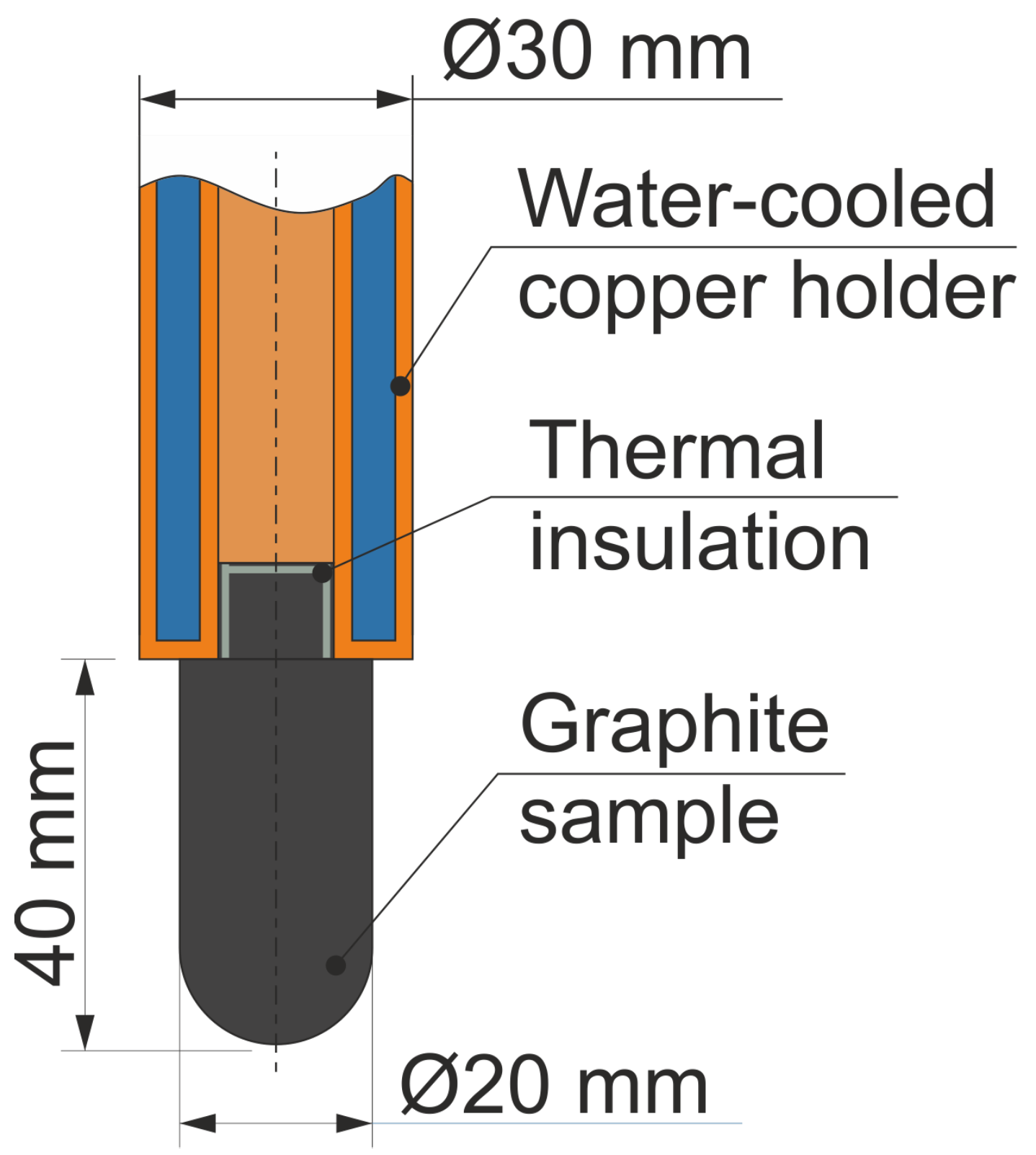
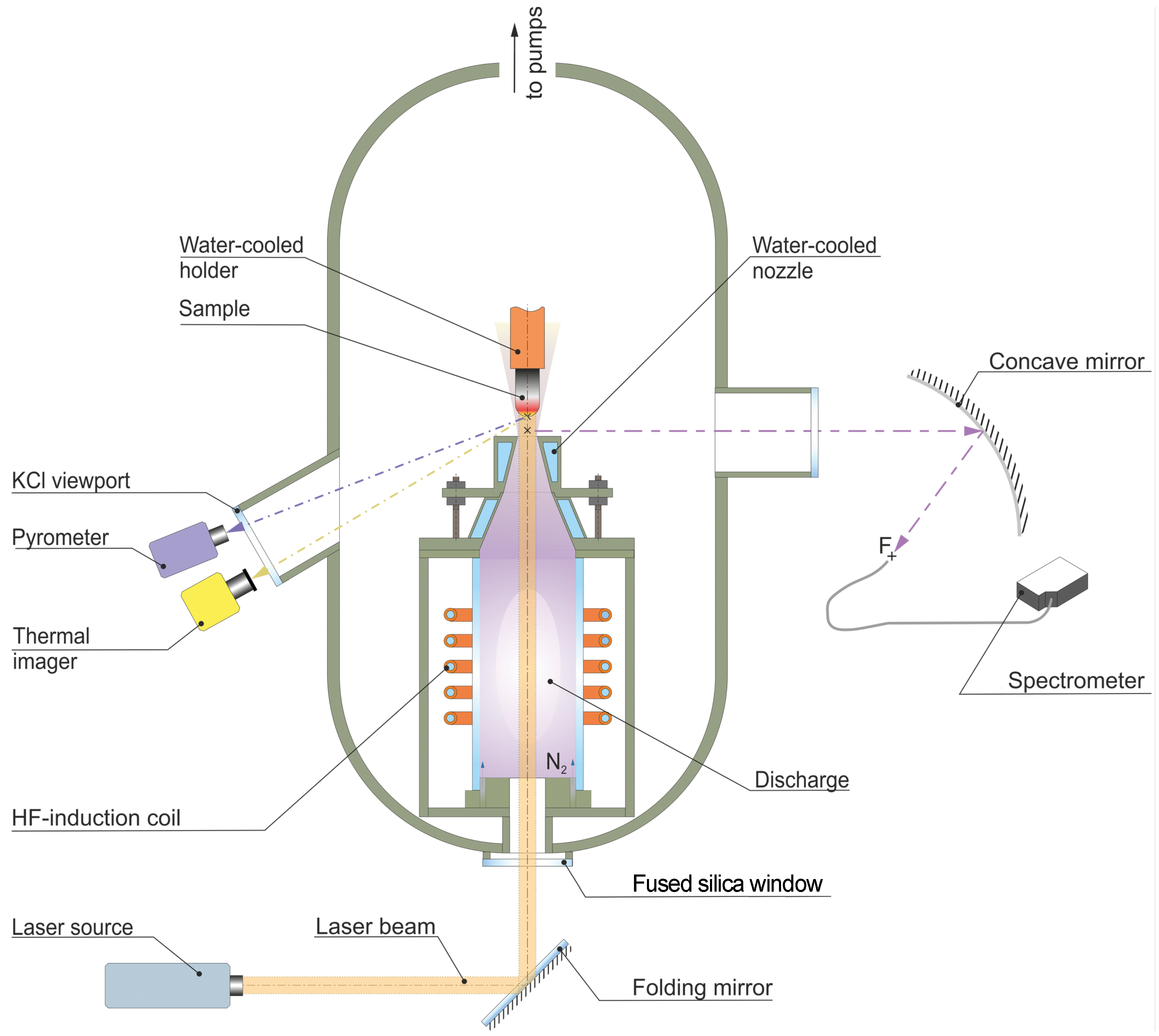
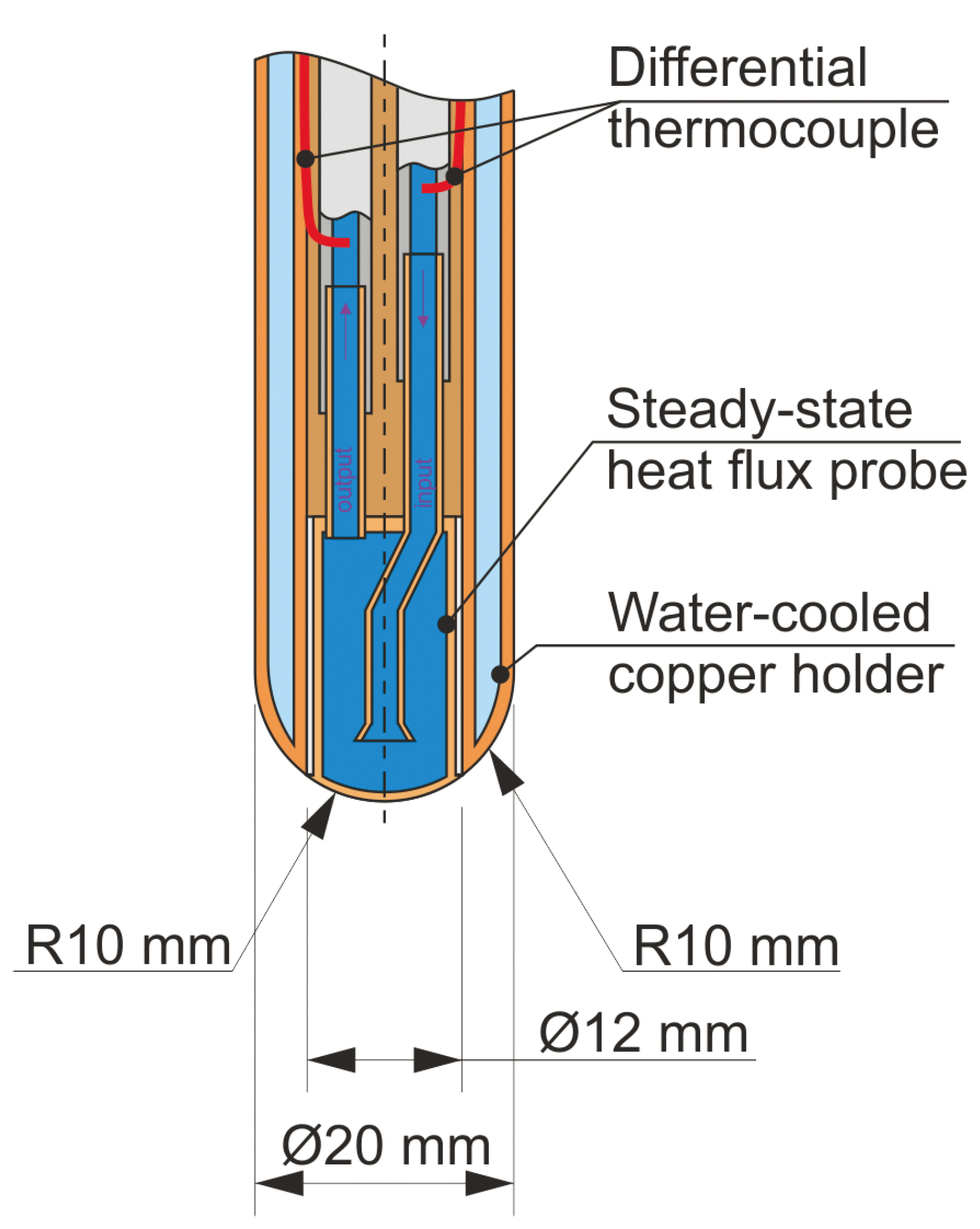
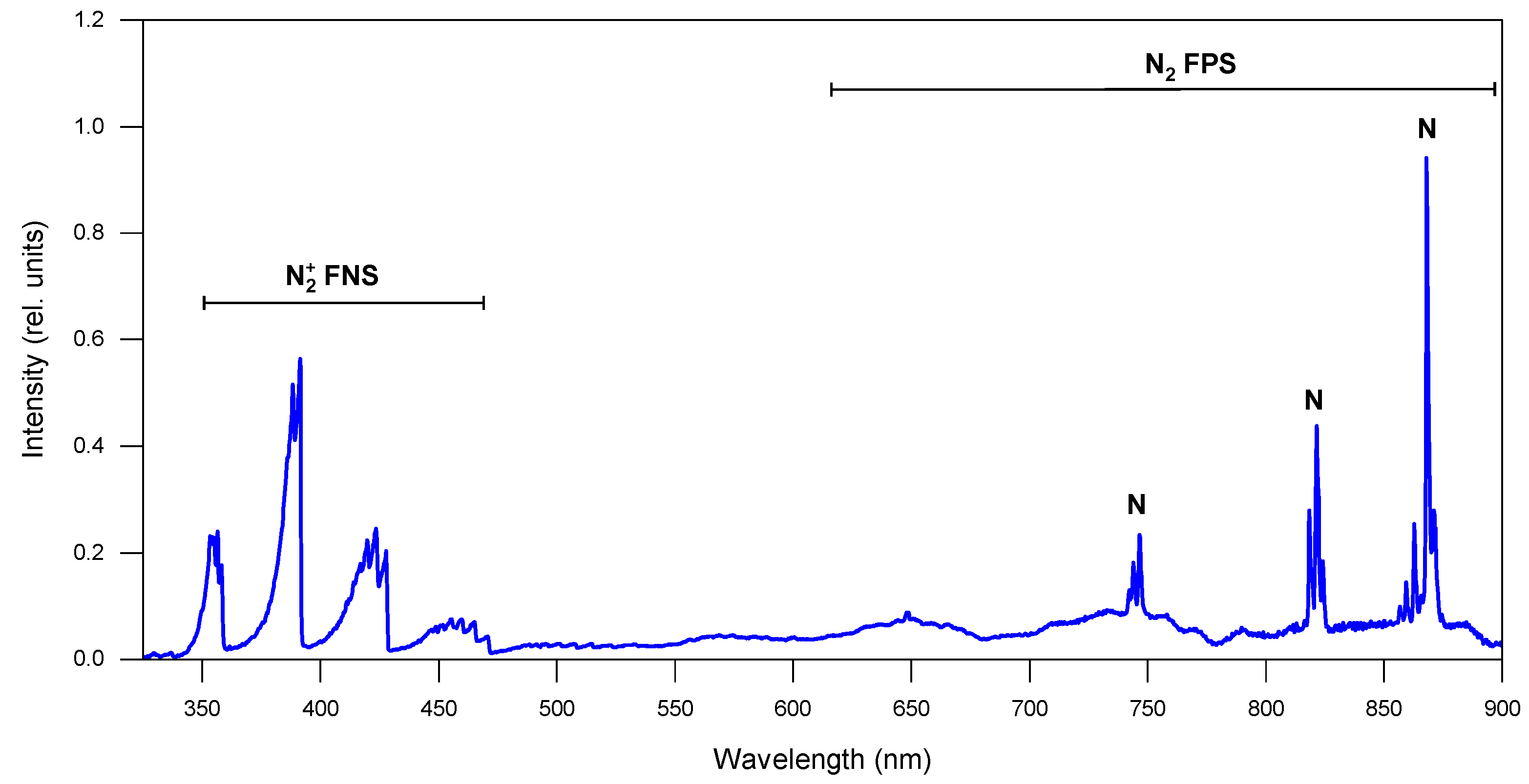
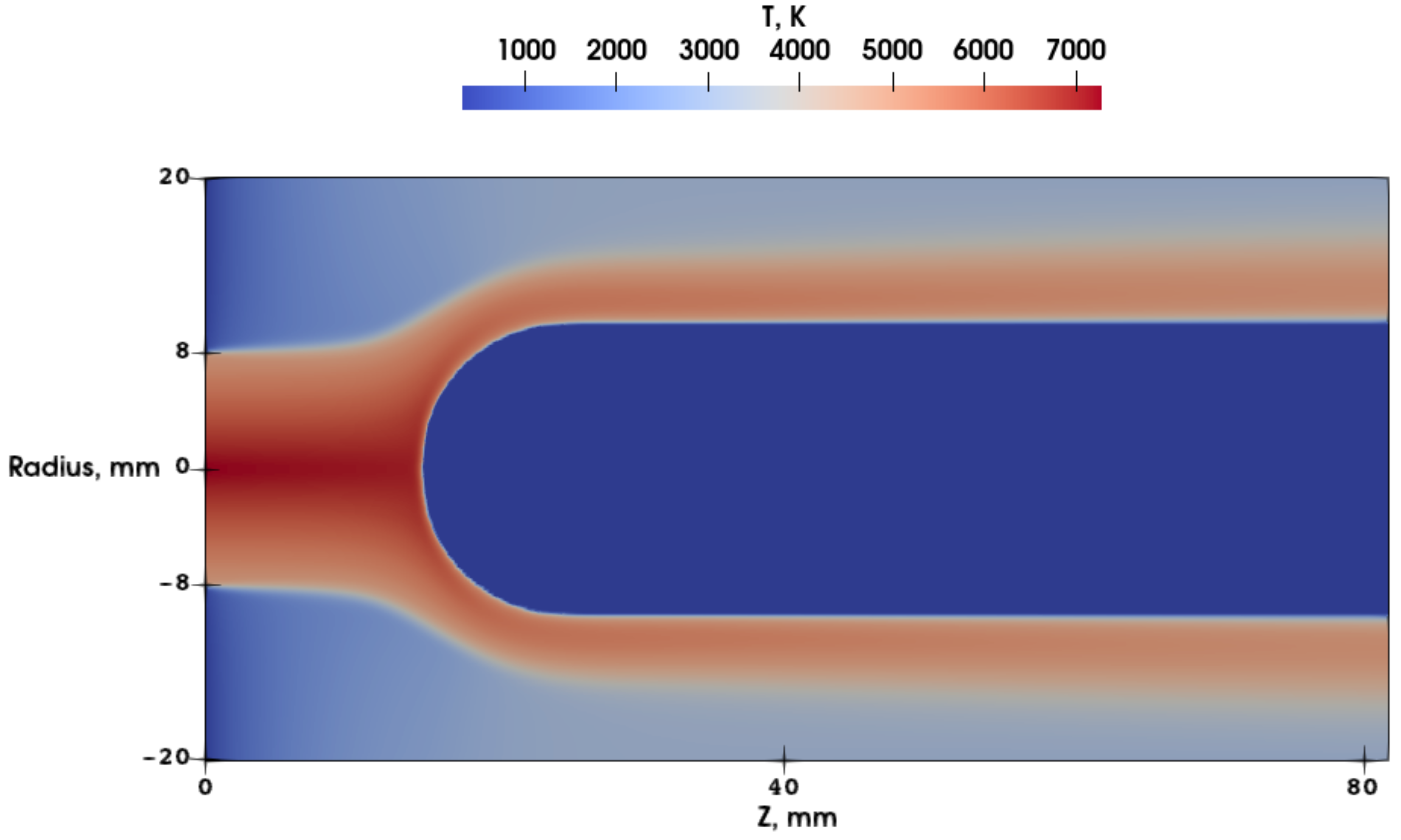
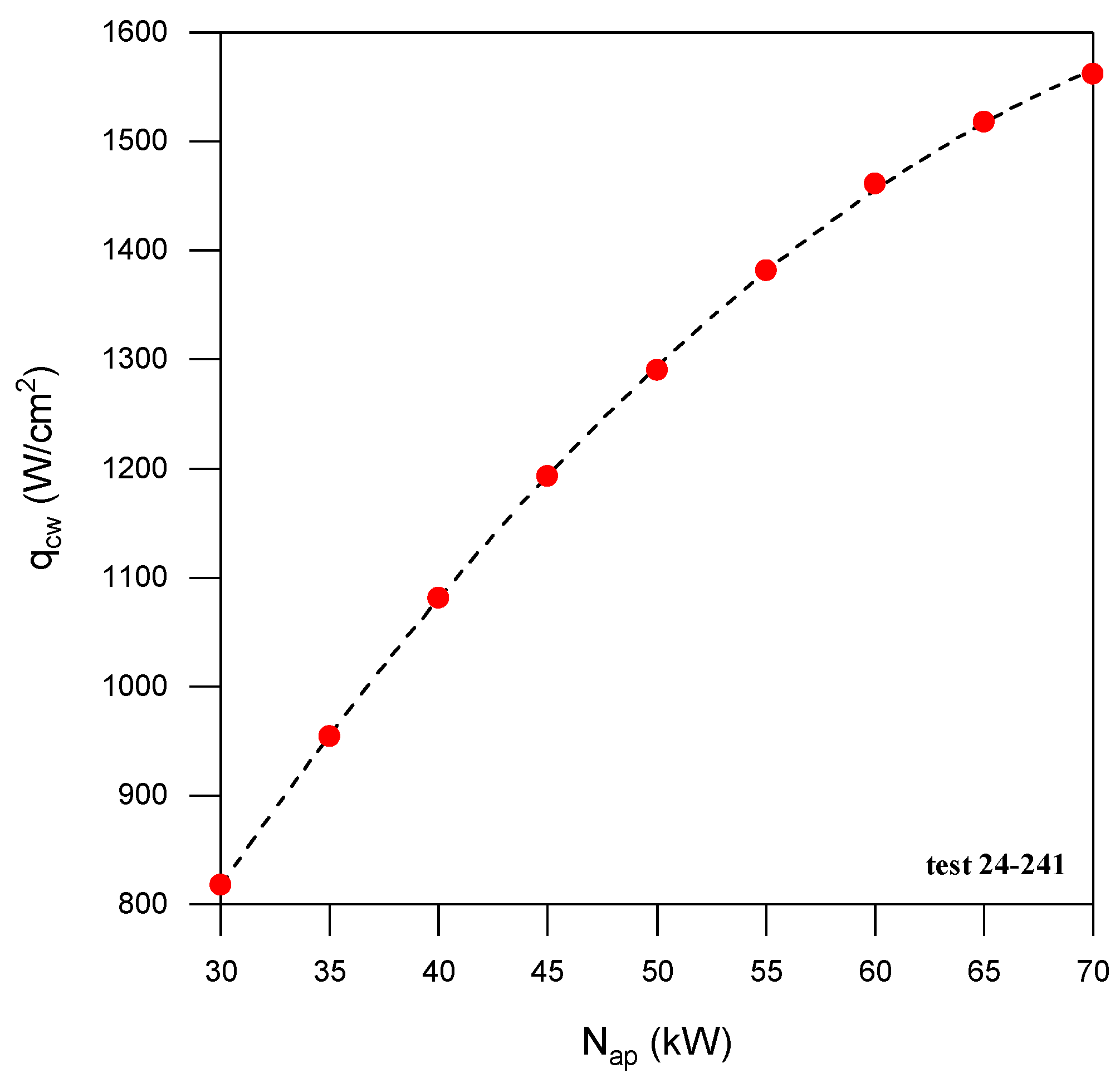
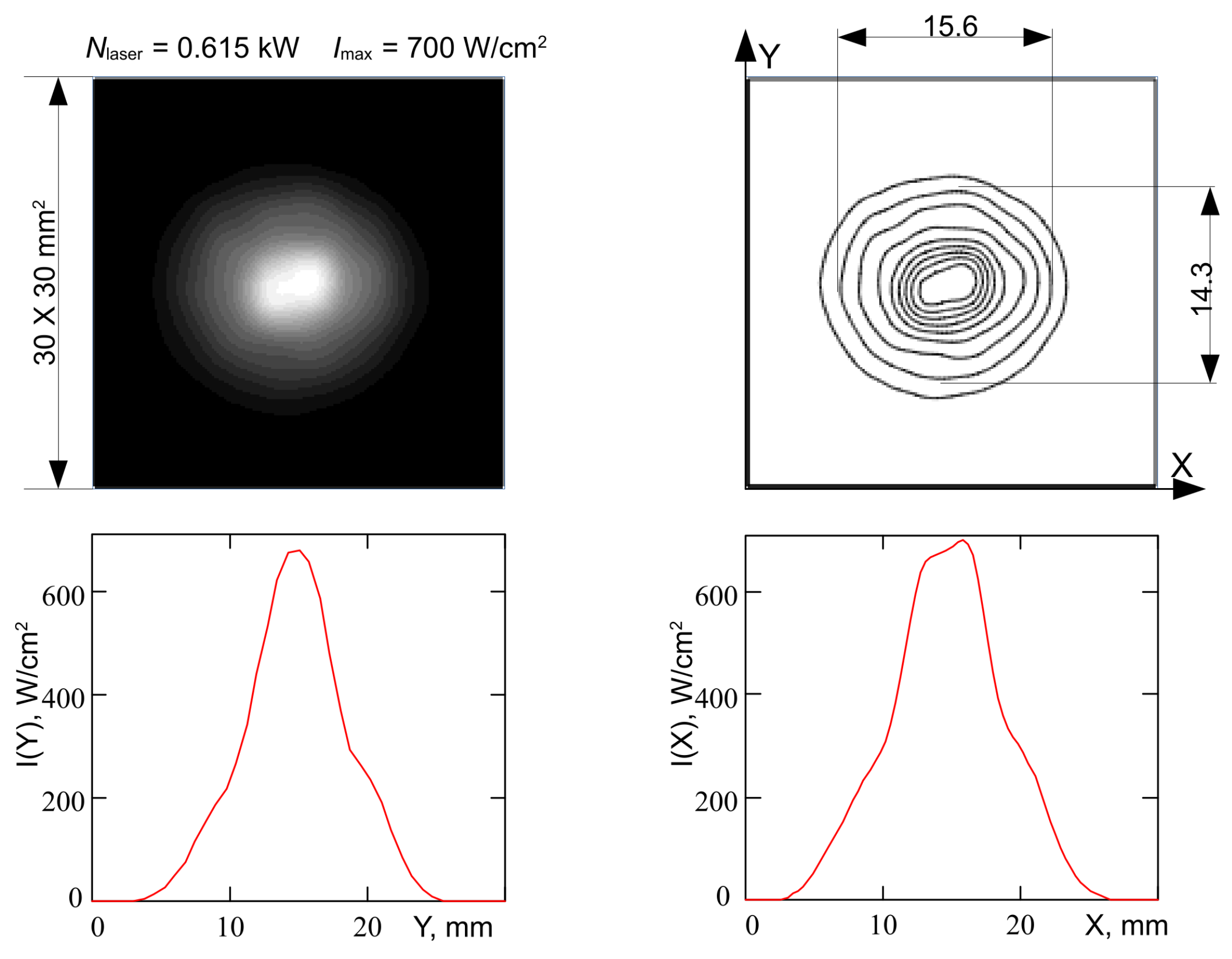
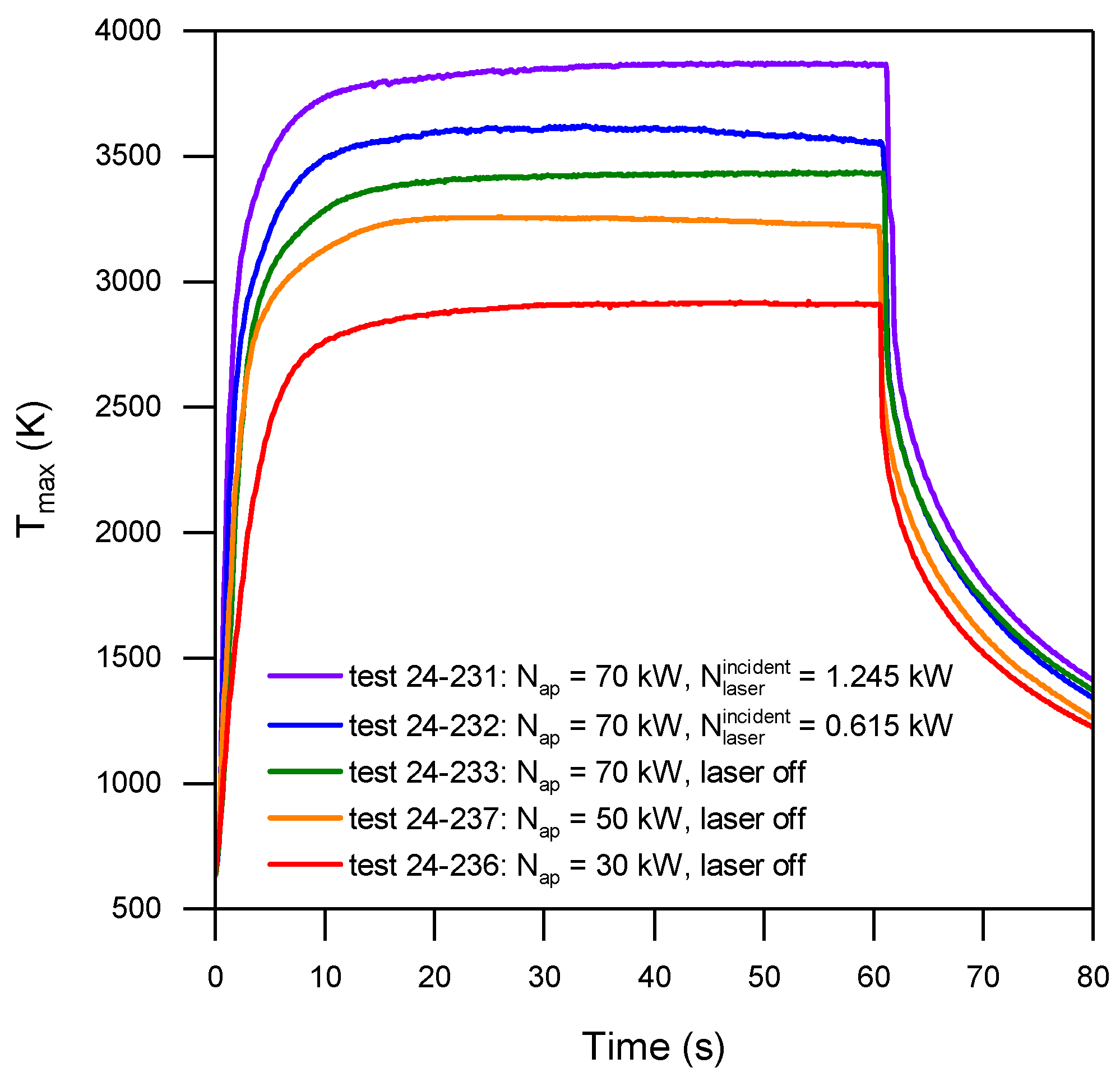
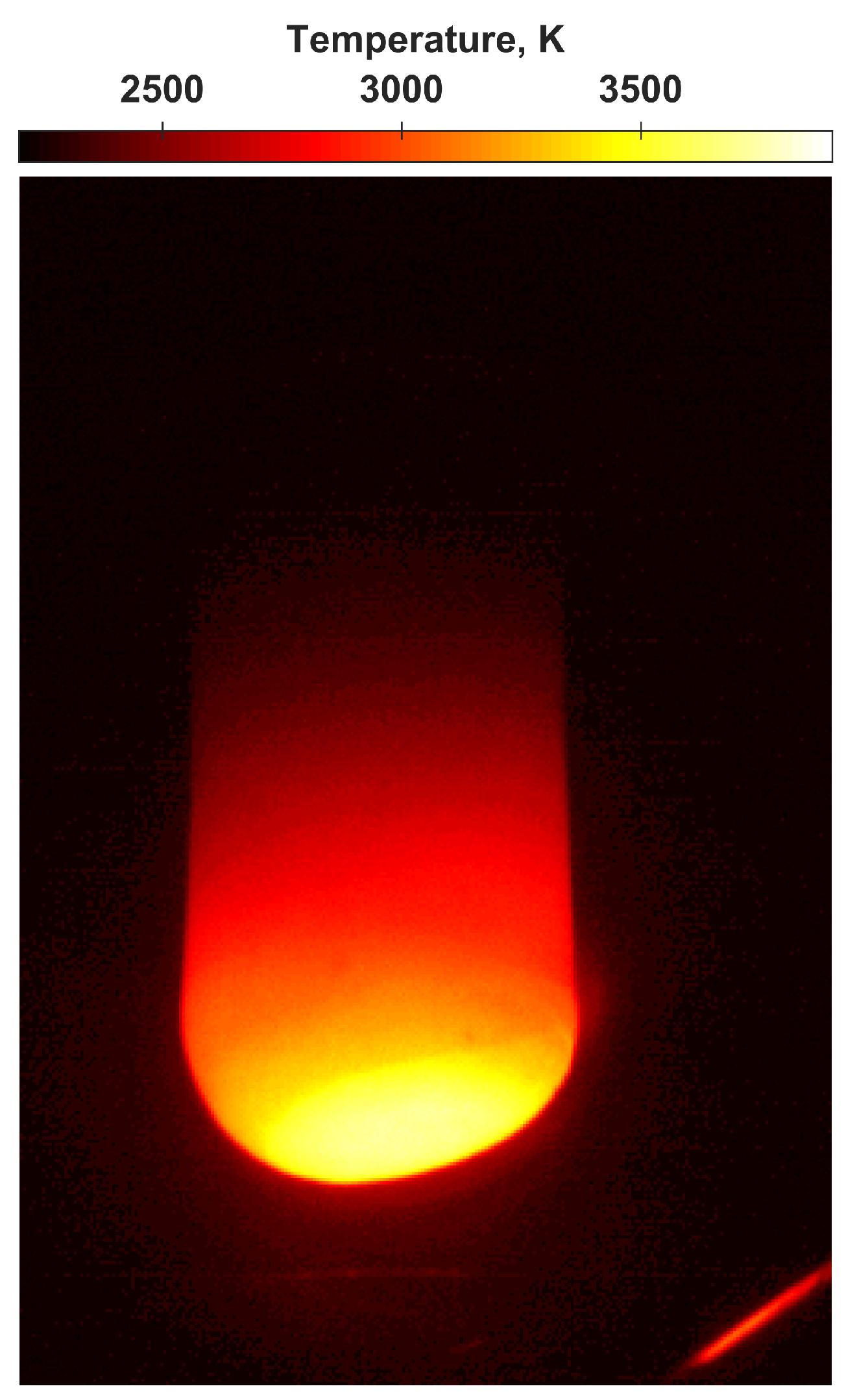
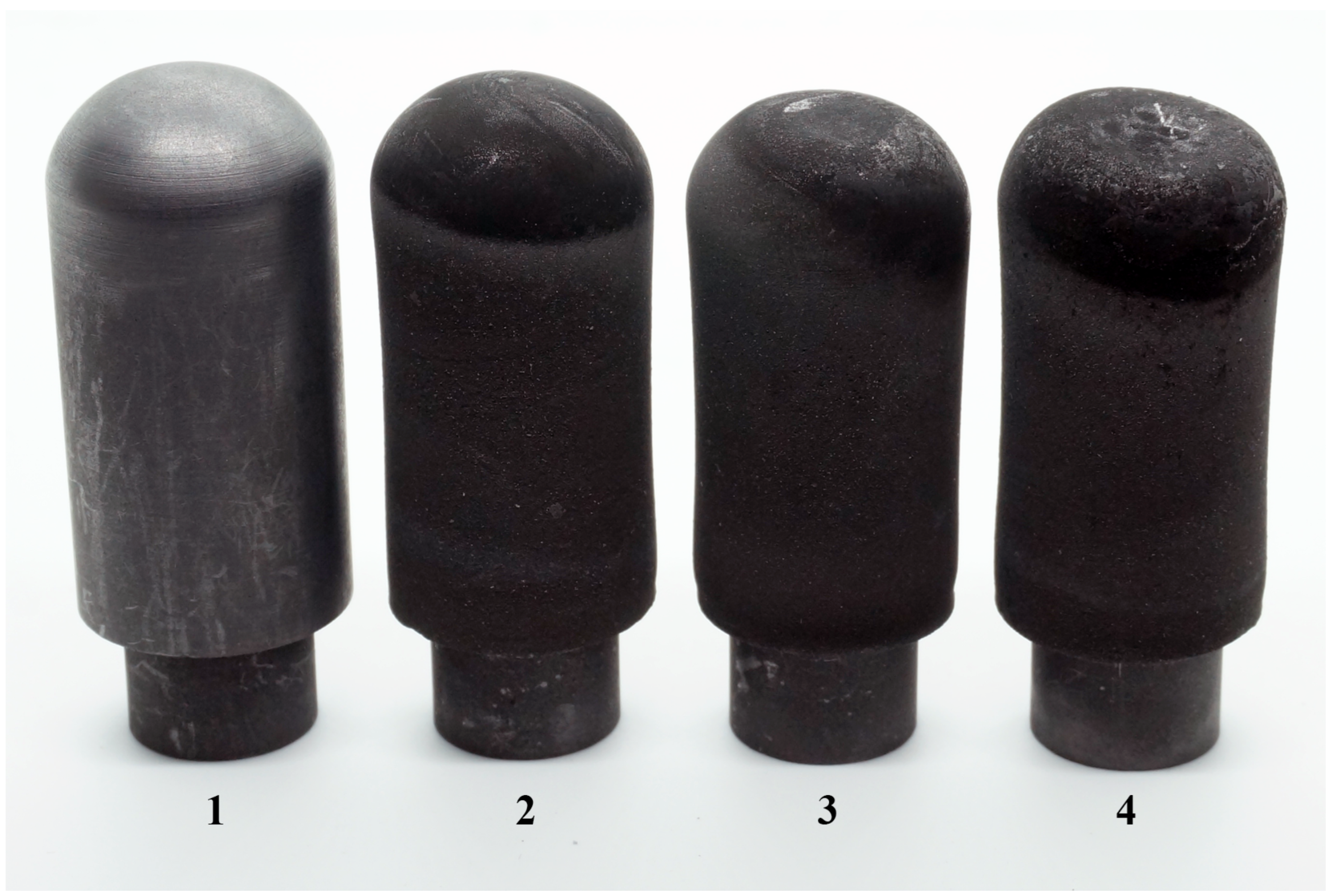
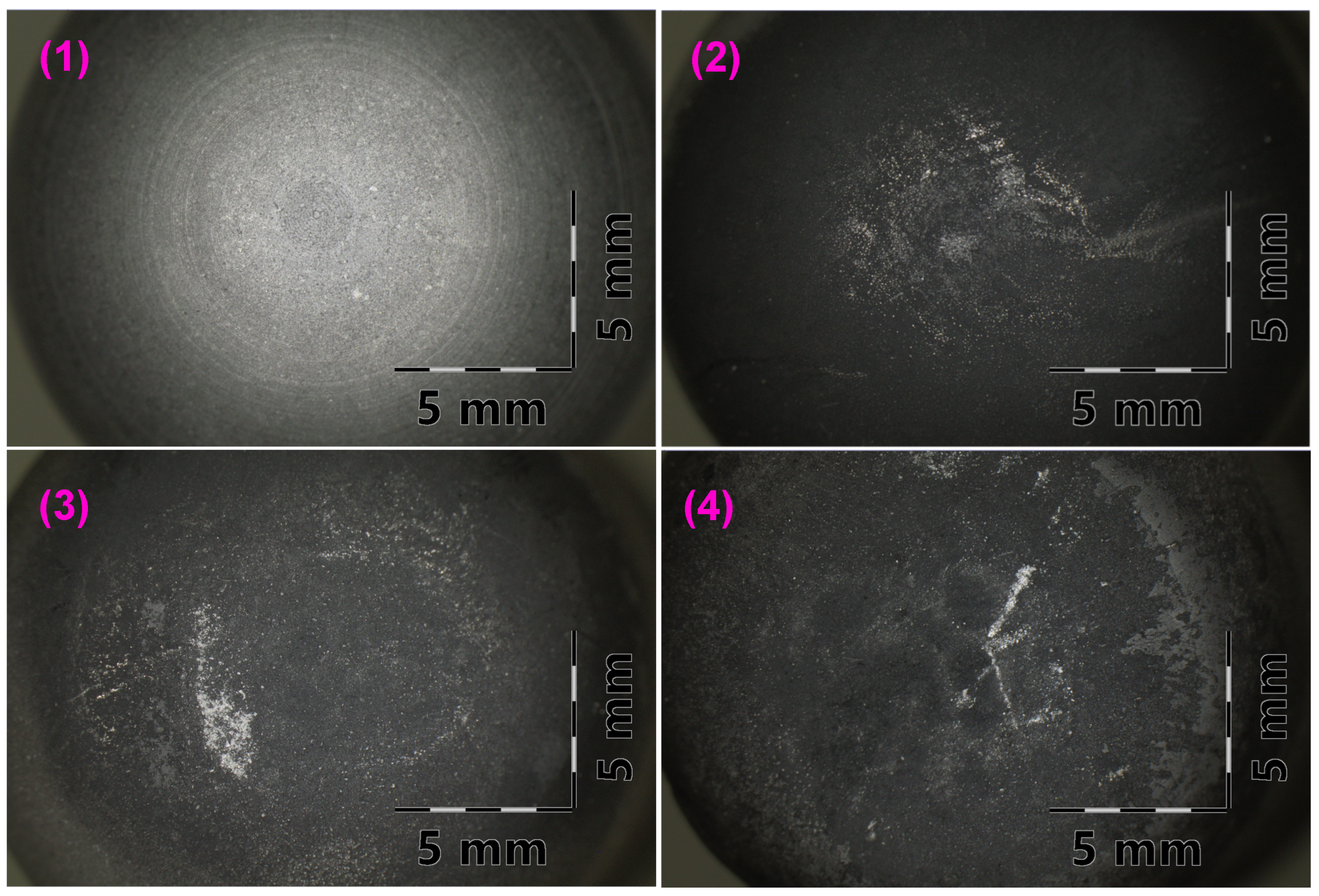
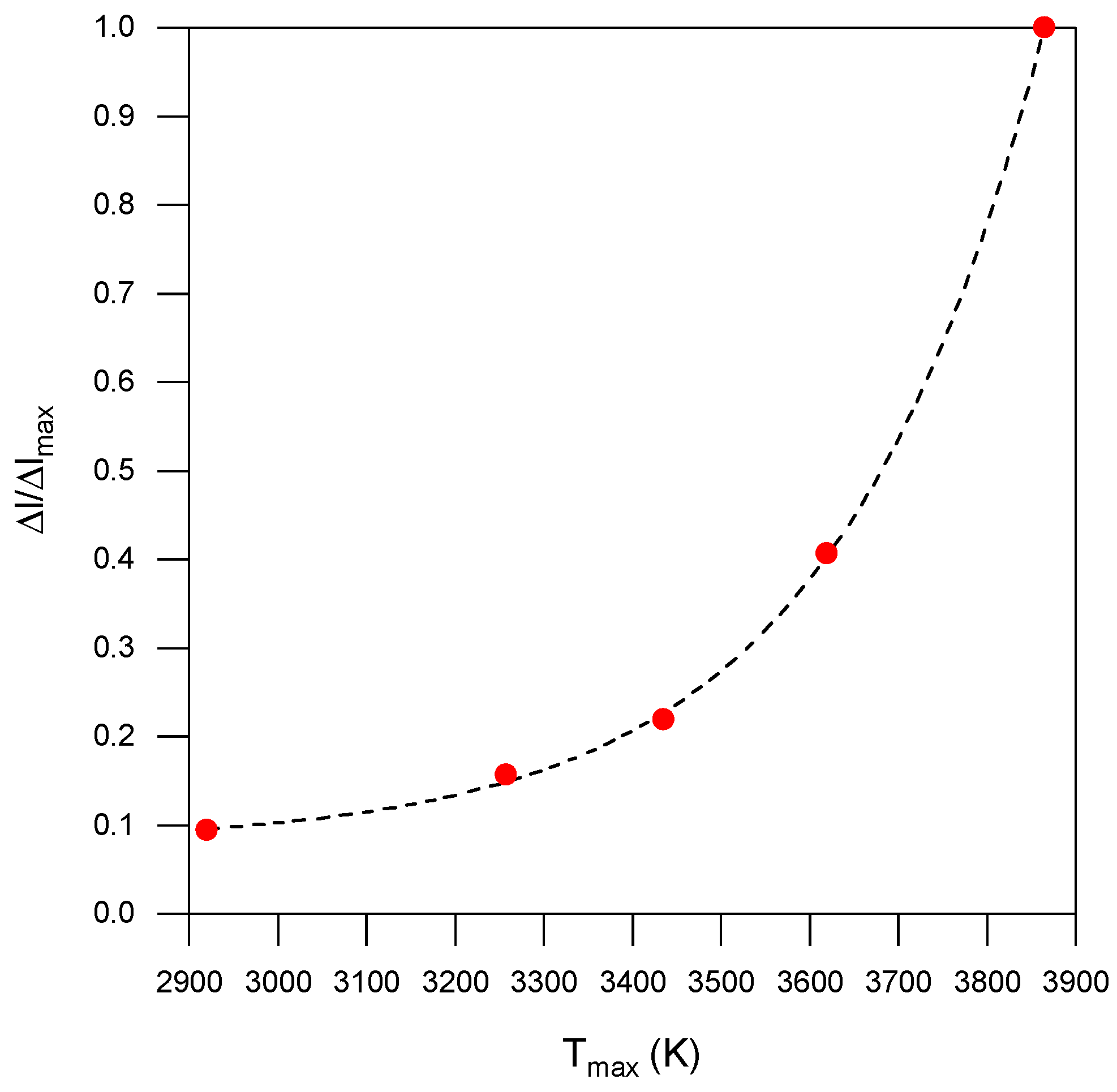
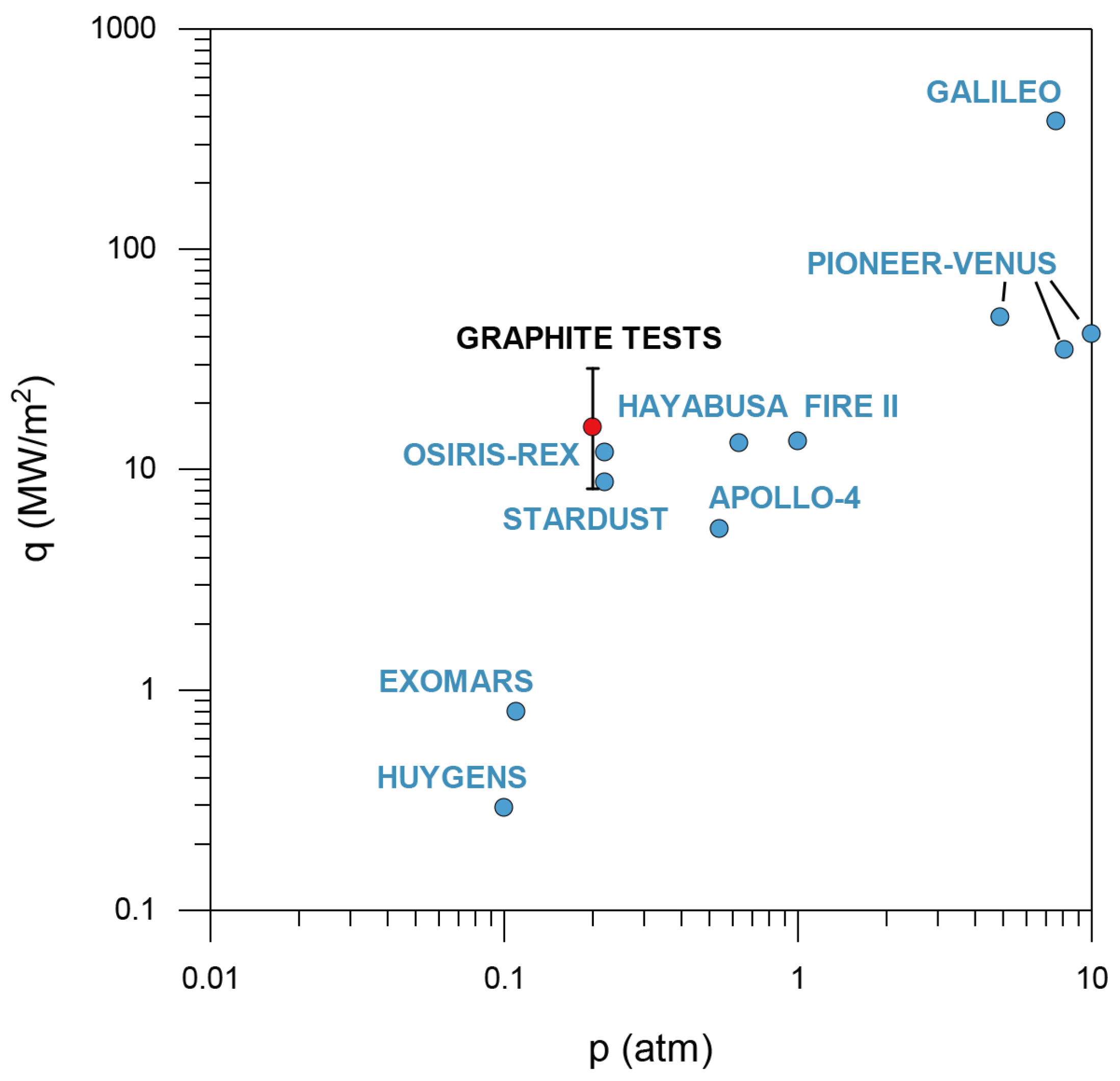
| p, Pa | T, K | X(N) | X(N2) | X(e) | X() | X() |
|---|---|---|---|---|---|---|
| 23,440 | 7323 | 0.90550 | 0.09132 | 1.607 × 10−3 | 1.560 × 10−3 | 0.471 × 10−4 |
| Test | , kW | , W | , W/cm2 | , W/cm2 | , K | , mm | , mm | , g | , g |
|---|---|---|---|---|---|---|---|---|---|
| 24-231 | 70 | 1245 | 1562 | 1440 | 3865 | 49.6 | 3.2 | 22.2093 | 1.7900 |
| 24-232 | 70 | 615 | 1562 | 700 | 3620 | 48.8 | 1.3 | 22.1356 | 1.5076 |
| 24-233 | 70 | 0 | 1562 | 0 | 3435 | 50.2 | 0.7 | 23.3946 | 1.4953 |
| 24-237 | 50 | 0 | 1290 | 0 | 3258 | 49.4 | 0.5 | 19.2531 | 1.2312 |
| 24-236 | 30 | 0 | 818 | 0 | 2920 | 49.7 | 0.3 | 20.2347 | 0.9772 |
Disclaimer/Publisher’s Note: The statements, opinions and data contained in all publications are solely those of the individual author(s) and contributor(s) and not of MDPI and/or the editor(s). MDPI and/or the editor(s) disclaim responsibility for any injury to people or property resulting from any ideas, methods, instructions or products referred to in the content. |
© 2025 by the authors. Licensee MDPI, Basel, Switzerland. This article is an open access article distributed under the terms and conditions of the Creative Commons Attribution (CC BY) license (https://creativecommons.org/licenses/by/4.0/).
Share and Cite
Chaplygin, A.; Yakimov, M.; Vasil’evskii, S.; Kotov, M.; Lukomskii, I.; Galkin, S.; Shemyakin, A.; Solovyov, N.; Kolesnikov, A. Combined Plasma and Laser Heating of Graphite. Plasma 2025, 8, 9. https://doi.org/10.3390/plasma8010009
Chaplygin A, Yakimov M, Vasil’evskii S, Kotov M, Lukomskii I, Galkin S, Shemyakin A, Solovyov N, Kolesnikov A. Combined Plasma and Laser Heating of Graphite. Plasma. 2025; 8(1):9. https://doi.org/10.3390/plasma8010009
Chicago/Turabian StyleChaplygin, Aleksey, Mikhail Yakimov, Sergey Vasil’evskii, Mikhail Kotov, Ilya Lukomskii, Semen Galkin, Andrey Shemyakin, Nikolay Solovyov, and Anatoly Kolesnikov. 2025. "Combined Plasma and Laser Heating of Graphite" Plasma 8, no. 1: 9. https://doi.org/10.3390/plasma8010009
APA StyleChaplygin, A., Yakimov, M., Vasil’evskii, S., Kotov, M., Lukomskii, I., Galkin, S., Shemyakin, A., Solovyov, N., & Kolesnikov, A. (2025). Combined Plasma and Laser Heating of Graphite. Plasma, 8(1), 9. https://doi.org/10.3390/plasma8010009








